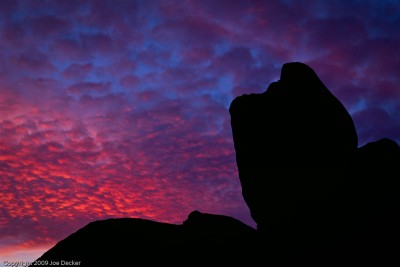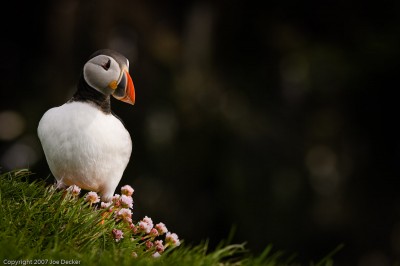If you like this article, you can now get the book! Joe has expanded the “Tuesday Composition” series into an inspiring new ebook on composition, especially for nature photography. Check it out: The Tuesday Composition.
I was recently struck by the fact that one of my puffin images, Puffin IV, had been selected into two different shows by two different groups of jurors for two quite competitive shows. I was a little surprised–I would not have thought, of my various images that have been included in shows in the last year, that it would be this particular image that fared best of the images I submitted.
My surprise, plus a sale or two, led me to “take another look” at the image. As you might expect (it is, after all, Tuesday), composition was at the heart of my surprise. If the main parts of a photograph are subject, light and composition (I think beginning photographers often focus too much on subject) it’s light on the subject and composition that really tend to pull together an effective photograph. There are far more interesting photographs of mundane subjects in interesting light and/or interesting compositions than the other way around.
There’s no question here that there’s an interesting subject (puffins really are wonderful subjects) and that the light is working as well enough. But neither light nor subject are enough to carry off this image alone. I’ve got hundreds more shots of puffins from the same location, many in similar light, but this one stands out. Why? Those of you who have been reading this column since the beginning will be able to pick out a large number themes I’ve touched on.
The bird is, as a whole, a highlight, so our eye naturally heads there. The bird, as well as some of the grasses and flowers, have high contrast, which pulls the eye there relative to the dark out-of-focus background, where the low contrast keeps our eyes from spending too much time examining. While there isn’t a lot of color in most of the image, the brightest colors pull our eye straight to the puffin’s head. The combination of which direction the puffin is looking, and his placement off-center in the image provide a sense of space and contributes to our sense that we can imagine what the bird is feeling.

I’ve probably missed a few more principles that apply, but that list is long enough for me to make my point: While none of those compositional principles by themselves hit me over the head when I look at Puffin IV, the sheer number of them contributing to how I see the image seem to work synergistically.
While an image like Alabama Hills Sunset nearly screams just one or two compositional principles at me, the puffin image achieves whatever strength it has through a chorus of quieter compositional voices that (I believe) harmonize successfully. I think that helped it “sneak by” my attention a bit, I think that’s why I found myself a little bit surprised.
One final word: Puffin IV provides a further example of a point I made last week, that learning these compositional rules is as much a way to build your photographic intuition and vision rather than an algorithm for making a good image. I’m sure that I didn’t consider all of these principles when I shot Puffin IV. I did think about some things –I knew I wanted some of the few flowers around there on the bird cliffs, and I really liked the idea of using the black volcanic rock cliffs as a backdrop to create tonal contrast. I also knew, I suppose, that I didn’t want the cliff walls in focus; they were messy, with not only birds (which are probably the source of light for the out-of-focus highlights) but numerous streaks of guano.
But, as in many cases, I “followed standard compositional guidelines” without conscious thought, simply by instinct and intuition.
